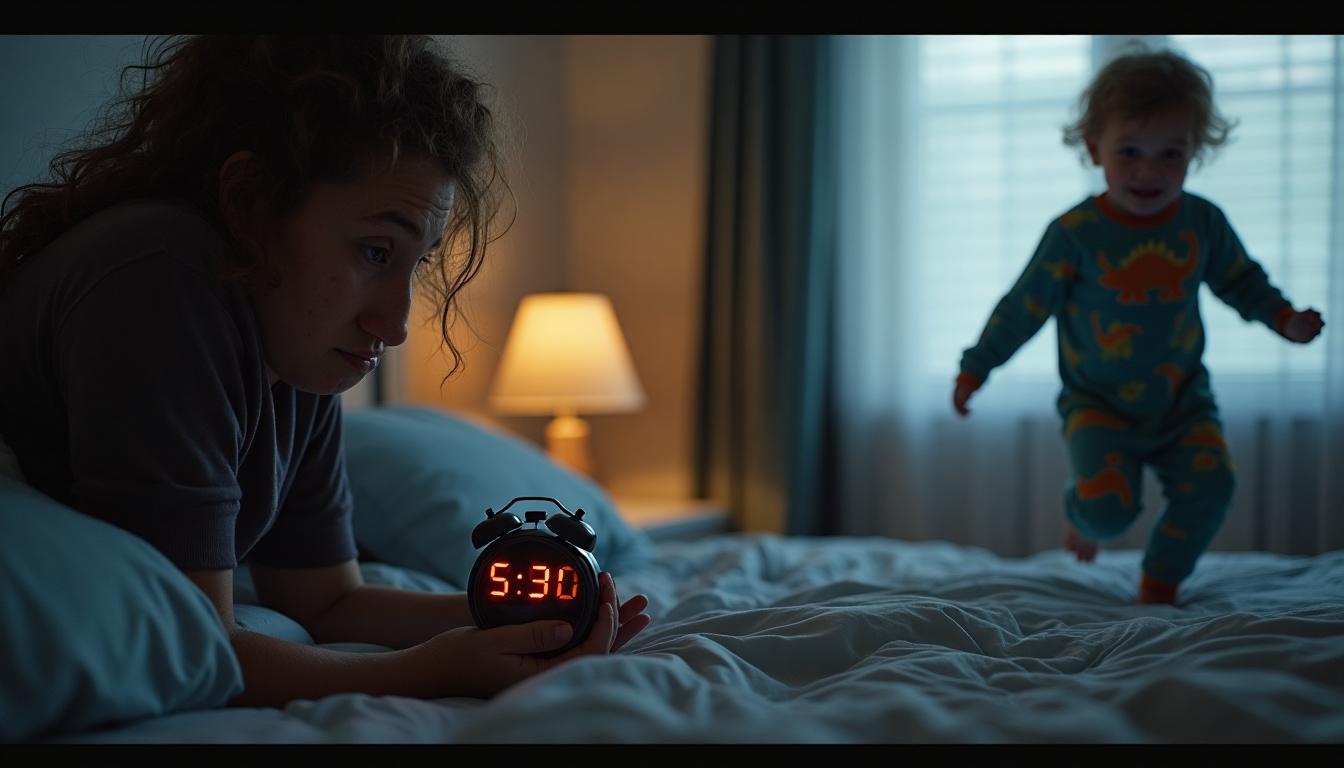The Daylight Saving Survival Guide Nobody Tells You About

Look, I'm gonna be real with you about this fall back thing
Last year, I was SO ready for that "extra hour of sleep" everyone talks about. Like, I actually put it on my calendar with little heart emojis. Spoiler alert: my 3-year-old didn't get the memo, and neither did my 18-month-old. Instead of sleeping in, I got twin tornadoes awake at what felt like 4:30 AM, demanding breakfast and cartoons while I questioned every life choice that led me to this moment.
So this year? We're doing things differently. And by "we," I mean you and me are going to figure out how to outsmart these tiny humans who somehow have zero respect for clock changes.
The Problem With "Just Go With The Flow" Advice
Here's what most sleep guides won't tell you: that whole "kids will naturally adjust" thing? Pure fantasy. Kids' circadian rhythms are basically the most stubborn thing on the planet, right up there with trying to get toothpaste back into the tube.
And can we talk about how all this advice assumes you have one perfectly scheduled child and infinite flexibility in your life? Like, what if you've got a baby AND a toddler? What if you're juggling work calls and school pickup times? What if your kid is already a hot mess sleeper and you're barely hanging on?
The good news is, there are actually some strategies that work in the real world. Not pinterest-perfect strategies, but "okay we survived and nobody's having a complete meltdown" strategies.
The Science-y Bit (But Make It Simple)
Before we dive into tactics, let's talk about why this is such a big deal. Kids' internal clocks are basically running their own show, completely independent of whatever we adults decide about time zones and clock changes. When we "fall back," your kid's body is still going to want to wake up at their normal time – which is now going to be an hour earlier by clock standards.
Think of it like this: if your kiddo usually wakes up at 6:30 AM, their body is going to keep waking up at what FEELS like 6:30... but the clock is now going to say 5:30 AM. And honestly? There's not enough coffee in the world for that.
Strategy 1: The Gradual Shift (AKA Operation Stealth Mode)
This is where we get sneaky. About 4-6 days before the time change, you're going to start gradually shifting everything – bedtime, naps, meals – later by small increments.
The Two-Track Approach:
- Fast track (4 days): Shift everything 15 minutes later each day
- Slow track (6 days): Shift everything 10 minutes later each day
So if bedtime is usually 7:00 PM, you'd start putting them down at 7:15, then 7:30, then 7:45, and so on. By the time the clocks change, their "8:00 PM" bedtime becomes a perfect "7:00 PM" on the new time.
Real talk moment: This sounds super organized and doable, right? Well, sometimes it is! And sometimes your toddler decides that the 15-minute later bedtime is actually party time and you end up with a rave in the nursery. That's when you pivot to...
Strategy 2: The Damage Control Plan
Maybe you're reading this the day before time change (hi, fellow procrastinators!), or maybe the gradual approach went sideways. Here's your backup plan:
The Dramatic Wake-Up Protocol: When they wake up too early, don't treat it like morning time. Keep things dim, boring, and definitely not fun. Then, when it's actually their proper wake-up time, go full Broadway: lights on, blinds up, "GOOD MORNING SUNSHINE!" energy that would make a Disney character jealous.
I learned this one the hard way when my daughter decided 5 AM was the new 6 AM and I accidentally reinforced it by making breakfast right away. Don't be like tired-Maya. Be like strategic-Maya.
Strategy 3: The Power of Morning Light
This one's actually backed by legit science and it works. Get those kids outside in natural light as soon as possible after their CORRECT wake-up time. Even 10-15 minutes helps reset their internal clock.
Obviously, if it's November and you live somewhere where morning looks like the apocalypse, even sitting by a bright window helps. We're not aiming for perfection here – we're aiming for "better than yesterday."
Strategy 4: Nap Management (Or: How to Keep Everyone Sane)
During the transition week, naps are your best friend. A well-rested kid handles change better than an exhausted one (shocking revelation, I know).
You might need to add an extra mini-nap to help them make it to the new, later bedtime. Yes, this might mess with your usual routine. Yes, it's temporary. Yes, it's worth it.
Pro tip: If you've got multiple kids on different nap schedules, this is where you call in reinforcements. Tag team with your partner, bribe the grandparents, trade favors with other parents – whatever it takes.
What Nobody Warns You About
Let me share some real-world complications that might come up:
If you've got multiple kids: Stagger your approach. Maybe start the baby 2 days before the toddler, or focus on whoever's the most sensitive to schedule changes first.
If someone gets sick: Scrap the plan. Seriously. Sleep transitions and illness don't mix. Just survive the week and try again when everyone's healthy.
If you're dealing with sleep resistance: Some kids will fight the later bedtime because they're not tired yet, then still wake up early because their internal clock hasn't shifted. This is temporary but awful. Extra patience, maybe some chamomile tea for you, and remember it's not permanent.
If work schedules don't cooperate: Do what you can when you can. Even partially shifting schedules helps more than doing nothing.
The Week After: Managing Expectations
Even if you execute this plan perfectly (and honestly, who does anything perfectly with kids?), expect some weirdness for about a week after the change. This might look like:
- Random middle-of-the-night wake-ups
- Resistance to the "new" bedtime
- Cranky afternoons while everyone adjusts
- You questioning whether any of this was worth it
Spoiler alert: it was. But also, give yourself grace during this period.
Your Sanity-Saving Toolkit
Here's what I wish someone had told me to prep before attempting this:
Stock up on: Easy meals, extra patience, backup childcare plans, and maybe some wine for after bedtime.
Lower expectations for: Perfect behavior, normal energy levels, your own productivity, and basically everything else for a week.
Call in help with: Household stuff, meal prep, or tag-teaming bedtime duties if you've got a partner.
Real Talk: When Plans Go Sideways
Sometimes, despite your best efforts, everything goes to hell. Maybe your kid gets sick, maybe work explodes, maybe you just forget what day it is (been there).
If you end up going "cold turkey" with the time change, you're not doomed. It just means you'll need to be extra patient and use those dramatic wake-up tactics for potentially longer.
And honestly? Some kids are just naturally adaptable and will figure it out in a few days regardless of what you do. Others need more support. Neither situation reflects your parenting skills.
Let's Get Interactive: What's Your Reality?
Before you dive into this, let's do a quick reality check:
How many kids are we working with? One kid = more control over variables. Multiple kids = more chaos but also they sometimes help regulate each other.
What's your current sleep situation? If things are already rocky, this might be trickier but also might not make things much worse.
How much flexibility do you have in your schedule? Be honest about this because it affects which strategy will actually work for your family.
What's your backup childcare situation? Because you might need reinforcements.
The Plot Twist Nobody Mentions
Here's something that might happen that no one talks about: the time change might actually improve things temporarily. If you've got an early riser, suddenly their 6 AM wake-up becomes 7 AM and you're like "wait, this is amazing!"
Don't get too comfortable though – their internal clock will try to drift back to the original time over the following weeks if you don't reinforce the new schedule.
Building Your Support Network
This is a perfect time to connect with other parents going through the same thing. Start a group chat, check in with neighbors, or just text your parent friends with updates on how it's going.
There's something weirdly comforting about getting a 6 AM text from another parent saying "Day 3 of time change hell, send coffee" and knowing you're not alone in this.
The Long Game
Look, here's the thing about parenting: every strategy works until it doesn't, and what works for one kid might be a disaster for another. The goal isn't to be perfect – it's to be intentional and realistic about what you're working with.
This time change thing happens twice a year (assuming you're in a place that still does daylight saving time – don't get me started on that debate). You're going to get multiple chances to figure out what works for your family.
My Final Reality Check
Last year's time change disaster taught me that sometimes the best strategy is just survival mode. This year, we're going to try the gradual approach, but I'm also preparing mentally for the possibility that it might not work perfectly. And that's okay.
The most important thing is that everyone eventually gets back to sleeping and you don't lose your mind in the process. Everything else is bonus points.
Your Action Plan
So here's what we're gonna do:
- Pick your approach (gradual shift vs. damage control) based on your reality
- Lower your expectations for the transition week
- Stock up on easy meals and backup plans
- Connect with other parents going through this
- Remember that this is temporary
And hey, if all else fails, there's always the nuclear option: embracing the chaos and just rolling with whatever sleep schedule emerges. Sometimes surrender is a valid strategy too.
What's your plan? And more importantly, what's your backup plan for when your plan goes sideways? Drop a comment because I guarantee other parents are wondering the same thing.
Remember: we're all just figuring this out as we go, and that's perfectly fine. You've got this, even when it doesn't feel like it.




